”Hi, my name is Francis. I am your travel guide to the roots of the London Underground and to the origins of the names of all stations currently in use. This is the fourth stage of our journey. Have a seat and relax! Here are the stations from Ickenham Town to Mornington Crescent.”
ICKENHAM
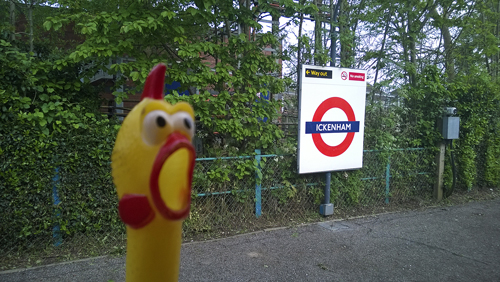
Ickenham was recorded as Ticheha in the Domesday Book and is derived from the personal name of the Saxon Ticea (or Ica) and the Old English ham,’a home’ – and means ’the home of Ica’ and his family who once lived on a site here. Recorded as Ikenham in 1236.
The station was opened as Ickenham Halt on 25 September 1905.
KENNINGTON

Kennington was recorded as Chenintune in the Domesday Book and is derived from the personal name of the Saxon Cena and the Old English tun, ’a farm’ – therefore it means ’the farm of Cena’, an early inhabitant of the area. It was recorded as Kenington in 1275.
Prior to the station’s opening the name of New Street was proposed, but it was opened as Kennington on 18 December 1890.
KENSAL GREEN
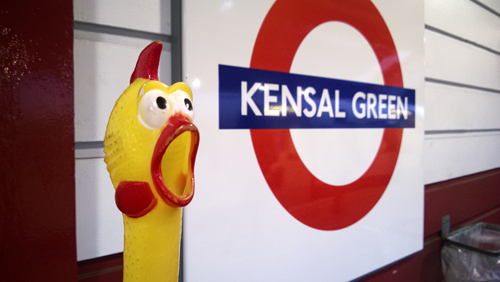
Kensal Green was recorded as Kingisholte in 1255 and means the King’s Wood (King and Old English holt, ’a wood’) but just who the royal owner was is unknown. The Green is recorded in 1550 and lies just south of the station; it includes the Kensal Green Cemetery.
The station was opened as Kensal Green on 1 October 1916.
KENSINGTON (OLYMPIA)
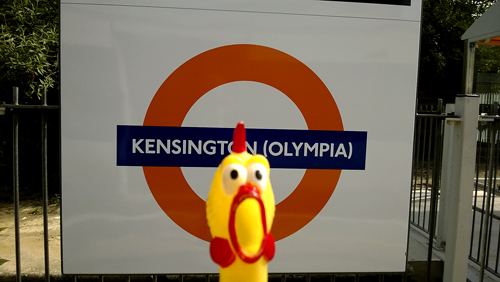
Kensington Olympia is recorded as Cheninton in the Domesday Book and the name is derived from the personal name of the Saxon Cynesige and the Old English tun, ’a farm’ – it means ’the farm of Cynesige’, another local agriculturist. It has had many variant spellings, with Kenesingeton recorded in 1274. Olympia is the name of the huge exhibition building opened in 1886 and extended to the main road in 1930.
The station was opened by the West London Railway as Kensington on 27 May 1844; re-sited farther north 2 June 1862; re-named Kensington (Addison Road) in 1868; re-named Kensington (Olympia) 19 December 1946.
KENTISH TOWN

Kentish Town stands recorded as Kentisston in 1208 and the name seems to be derived from a farm held by someone nick-named le Kentiss(h) – and means Kentish Farm, but the real history of the name is, however, unknown. It was only coincidence that Charles Pratt, Earl Camden, obtained through his marriage the Manor of Kentish Town in 1791. He in fact took his name from Camden Place in Kent. The Town developed in the later part of the 18th century as an industrialized area of north west London.
The station was opened as Kentish Town on 22 June 1907.
KENTON
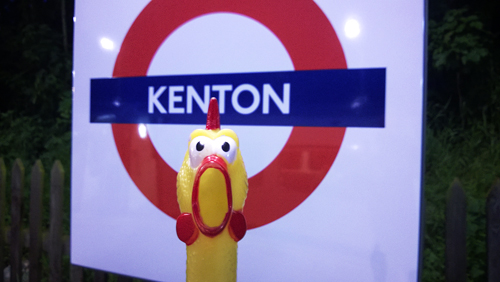
Kenton was recorded as Keninton in 1232 and the name is derived from the personal name of the Saxon Coena and the Old English tun, ’a farm’ – and means ’the farm of Coena’ and his family who once lived on a site here (see the similarity with Kennington).
The station was opened as Kenton by the London & North Western Railway on 15 June 1912 and first used by Underground trains on 16 April 1917.
KEW GARDENS
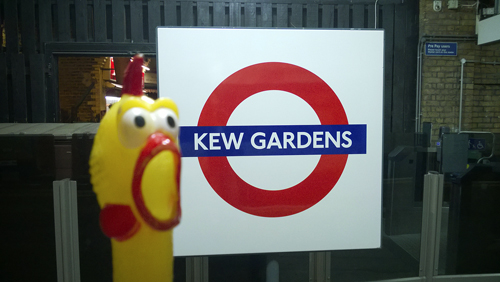
Kew Gardens, officially the Royal Botanic Gardens, were founded in 1759 by Princess Augusta (mother of George III) in the grounds of Kew House and Richmond Lodge. Kew House was demolished in 1802. Noted for its great variety of plants and wild-life, the gardens now cover 288 acres and were given to the nation by Queen Victoria 1841. Kew is the name of this district on the south bank of the Thames and its name is derived from the Middle English Key – meaning ’a quay or wharf’.
The station was opened as Kew Gardens by the London & South Western Railway on 1 January 1869 and first used by Underground trains on 1 June 1877.
KILBURN
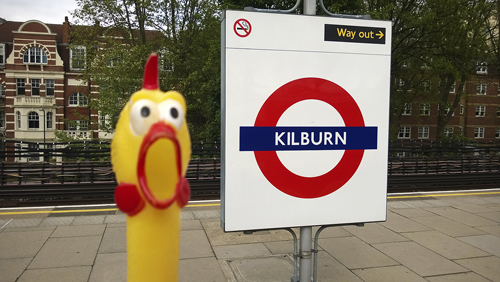
Kilburn, recorded as Cuneburna in 1121, takes its name from a stream which rose in Hampstead and flowed across West London, finally joining the River Thames near Chelsea Bridge. Only parts of the stream are in existence today and it has other names in different locations. Where it once turned south to Kilburn High Road it was known as Kylbourne (1502). The name is derived from the Old English cyne-burna, ’royal stream’ or ’cows’ stream’. Although Cylla (a once local inhabitant of the area) has also been given as a possible derivation, the first definition seems correct.
The station was opened as Kilburn & Brondesbury on 24 November 1879; re-named Kilburn on 25 September 1950.
KILBURN PARK
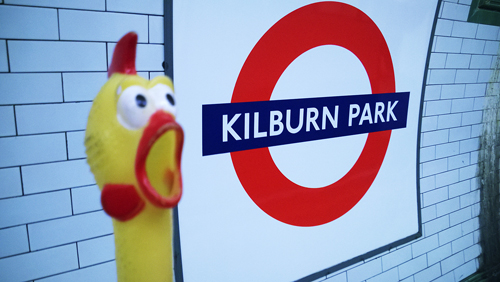
See Kilburn. The only remaining link with the Park today is the Kilburn Park Road to the south of the station.
The station was opened as Kilburn Park on 31 January 1915.
KINGSBURY
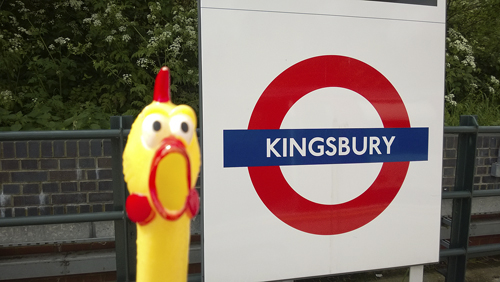
Kingsbury was recorded as Kynges byrig in 1046 and as Chingesberie in the Domesday Book. The name is derived from Kings and the Old English burh, ’a fortified place’ and means the ’King’s manor or stronghold’. The manor was granted to Westminster Abbey by Edward the Confessor (reigned 1042–66) and the association of the area with a King goes back to at least 957, when the woodland in the parish was referred to as Kings Wood. It has had various spellings, being known as Kyngesbury in 1199.
The station was opened as Kingsbury on 10 December 1932.
KING’S CROSS ST PANCRAS
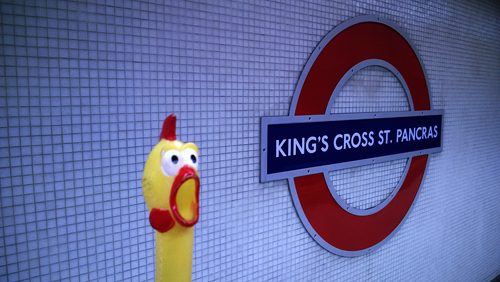
The district of north London now known as King’s Cross was originally called Battlebridge, traditionally the site of one of the battles between Boudicca (Boadicea), the British Queen of the Iceni, and the Romans about A.D. 59 or 61 at the bridge over the River Fleet. A corruption in the Cockney dialect of Bradeford (’broad ford – over the Holborn or Fleet River) was recorded in 1207. Later, however, the district took its present name from a statue of King George IV which stood from 1830–45 at the crossroads here. This name was generally in use when the then Great Northern Railway adopted it for its terminus in 1850. St Pancras was once a solitary village and later a manor granted by Ethelberg (reigned 860–866) to St Paul’s Cathedral. Recorded as Sanctum Panctatiú in the Domesday Book, the old village took its name from the church dedicated to the boy martyr St Pancras (Pancratius). Accordion to tradition this site is one of the first near London on which a church was built, but now the old church (much restored) lies nearly forgotten behind the Midland Railway main-line station named after it, which was opened in 1868. Tradition has it that the station is situated on part of Caesar’s camp dating from c. BC50.
The Metropolitan line station was opened on 10 January 1863 as King’s Cross; re-named as King’s Cross & St Pancras in 1927 and King’s Cross St Pancras in 1933. It was replaced by a new station farther west on 14 March 1941; this new station was adjacent to the tube stations for the Piccadilly Line (which was opened on 15 December 1906) and the Northern Line (opened on 12 May 1907). Building the Victoria Line involved extensive reconstruction, the present station being brought into use on 1 December 1968.
KNIGHTSBRIDGE
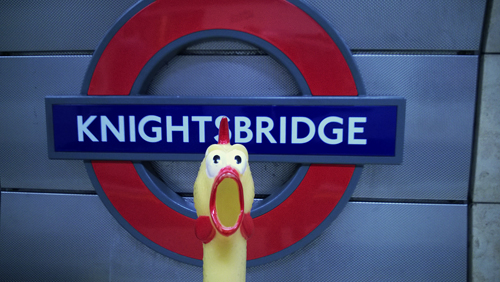
Knightsbridge was recorded as Cnihtebricge in 1046 and can be interpreted as meaning ’the bridge of the young men’. It appears that these men were responsible for the upkeep or the defence of the bridge over the Westbourne stream where it crossed the Great West Road. The street has had many variant spellings and was known as Knyghtesbrugg 1364. One story has it that this was the place where knights had their jousting tournaments in days gone by, but this should be taken with that often used ’pinch of salt’. The stream still flows under Albert Gate, Kightsbridge, but is now buried deep in a sewer pipe.
On early plans the station’s name was shown as Sloane Street, but it opened as Knightsbridge on 15 December 1906.
LADBROKE GROVE
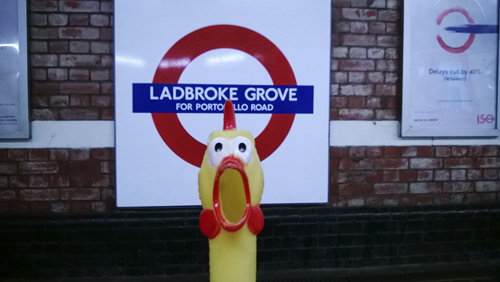
Richard Ladbrook owned the land here in 1624 and his family sold it for building purposes in 1845, giving their name to this long street running to the north of the station.
The station was opened as Notting Hill on 13 June 1864; re-named Notting Hill & Ladbroke Grove 1880; re-named Ladbroke Grove (North Kensington) on 1 June 1919 and Ladbroke Grove in 1938.
LAMBETH NORTH
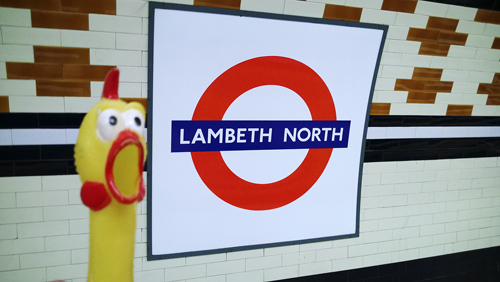
The name Lambeth is a reminder of the days when ships from all parts of the world sailed into the hearth of London along the River Thames. Recorded in 1041 as Lambhyo and as Lanchei in the Domesday Book, it is derived from the Old English Lambe and hythe, ’a haven’ or ’port’ – and means ’the port where lambs or cattle are shipped’. The suggestion that the first element of the name is from the Old English lam ’dirt’ or ’mud’ can be discounted.
The station was opened as Kennington Road on 10 March 1906; re-named Westminster Bridge Road on 5 August 1906 and Lambeth North on 15 April 1917.
LANCASTER GATE

Lancaster Gate is one of the gates into Hyde Park and could have received its name in honour of Queen Victoria, in her capacity as Duchess of Lancaster. A street of the same name, roughly opposite the gate was built in 1863–66.
Prior the station’s opening the name of Westbourne was proposed, but it opened as Lancaster Gate on 30 July 1900.
LATIMER ROAD
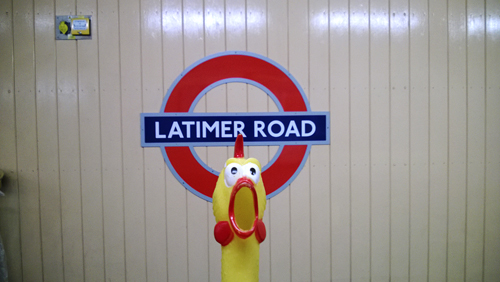
Edward Latymer, who died in 1626, bequeathed the land either side of the road to support the scholars of Latymer school in which he took an interest. The road runs north west of the station and ran closer to it prior to the building of Westway. What remains of its southern half is now named Freston Road.
The station was opened as Latimer Road on 16 December 1868.
LEICESTER SQUARE

In 1631 Robert Sidney, 2nd Earl of Leicester, later British Ambassador to France (1636–41), obtained a licence to build his London residence here at a place then known as Lammas Land. The square, which takes its name from the Earl, was laid out in 1665, being called Leicester Fields and later Square, being converted to a public garden in 1874. Leicester House was built on the north side in 1637, pulled down in 1790, rebuilt in the early 19th century and destroyed by fire in 1865.
On early plans the station’s name was shown as Cranbourn Street, but it opened as Leicester Square on 15 December 1906.
LEYTON
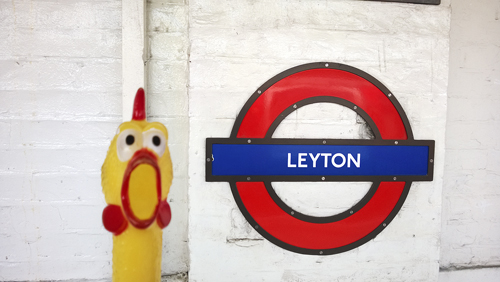
Leyton was recorded as Lugetune c. 1050 and Leyton in 1226. It is derived from Lea (the river) and the Old English tun, ’a farm’ – and thus means ’the farm on the River Lea’. Lea is a Celtic name possibly meaning ’light river’ or ’sparkling stream’.
The station opened as Low Leyton by the Eastern Counties Railway on 22 August 1856; re-named Leyton on 1 January 1868. First used by Underground trains on 5 May 1947.
LEYTONSTONE
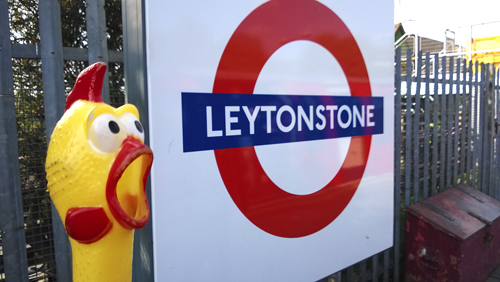
Leytonstone has the same meaning as Leyton with the addition of the word ending, stone. Recorded as Leyton at(te) Stone in 1370, tradition explains that this spot is near Leyton and the High Stone, a boundary mark.
The station opened as Low Leytonstone by the Eastern Counties Railway on 22 August 1856 and was first used by Underground trains on 5 May 1947.
LIVERPOOL STREET
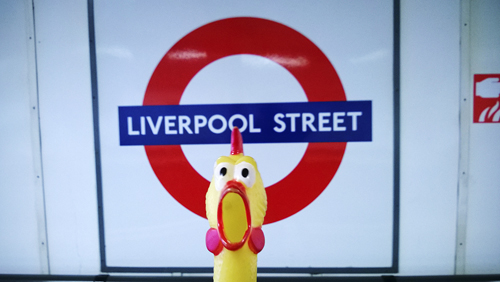
In 1246, on the site now occupied by the station, a priory was erected (later to become the Bethlehem Hospital) which stood here until 1676 when it was removed to London Wall. In 1829 the street was widened and named in honour of Lord Liverpool, who was Prime Minister from 1812–27. The whole area was cleared after 1864 for the building and opening for local traffic of the Liverpool Street main-line station of the Great Eastern Railway in 1874. Metropolitan Line trains ran into it between 1 February and 11 July 1875.
The Metropolitan Railway station was opened as Bishopsgate on 12 July 1875 and re-named Liverpool Street on 1 November 1909. The Central Line reached Liverpool Street on 28 July 1912.
LONDON BRIDGE
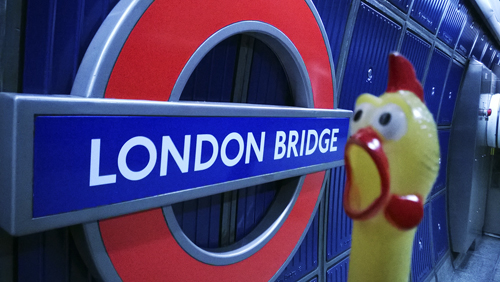
It is possible that there was a bridge not far east of the present one in the year 43 and there have been many bridges across the River Thames here in the course of history, the fifth and the latest one being opened in March 1973 and the old bridge being sold and re-erected stone by stone in Arizona. The poem which opens ’London Bridge is falling down’ refers to the battle in 1014 between King Aethelred of the English and the Danes, after which the bridge collapsed. London, recorded as Londonium c. 115 is a Celtic place-name probably formed a personal name Londinos – meaning ’the bold one’.
The Underground station was opened as London Bridge on 25 February 1900.
LOUGHTON
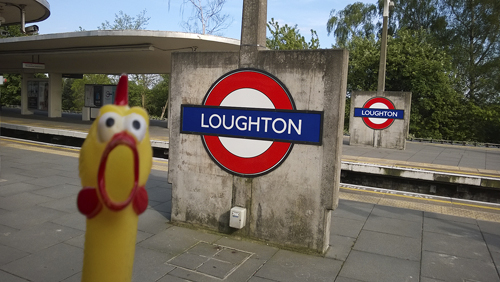
Loughton, recorded as Lukintone in 1062 and as Lochetuna in the Domesday Book, is derived from the personal name of the Saxon Luhha (or Luea) and the Old English tun, ’a farm’ – it means ’the farm of Luhha’, an early local Essex inhabitant.
The original station was opened as Loughton by the Eastern Counties Railway on 22 August 1856. It was re-sited on 24 April 1865. A new station was opened on 28 April 1940 in readiness for Underground trains, which took over the service from British Railways (Eastern Region) on 21 November 1948.
MAIDA VALE
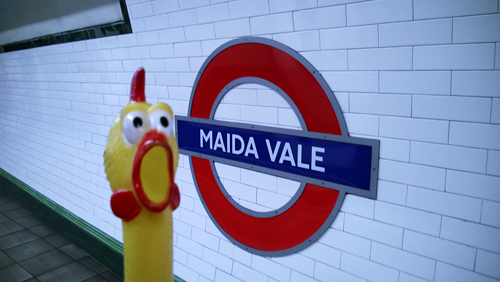
Maida Vale, though used as the name of a district, is really only a street name. It takes its name from Maida, a town in Calabria, Italy, where Sir John Stuart defeated the French in 1806. The street was mentioned in 1868, runs north to south and is, in fact, part of the Edgware Road.
Prior the station’s opening the name of Elgin Avenue was proposed, but it opened as Maida Vale on June 6 1915.
MANOR HOUSE
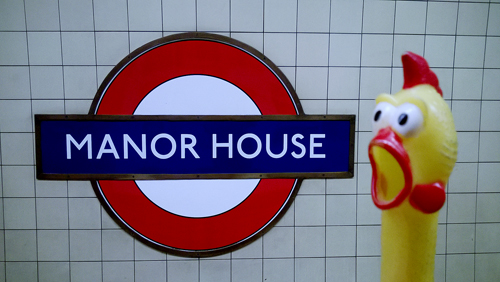
Close by the station stands the Manor House public house. Known as the ’Manor Tavern’ when it was built in c. 1820 as a stopping place for travellers between London and Cambridge, it was re-named in 1931 after a manor house situated opposite. At this time the public house was rebuilt and the house demolished to make way for St Olave’s Church.
The station was opened as Manor House on 19 September 1932.
MANSION HOUSE
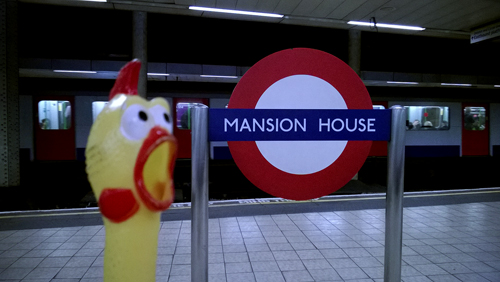
Mansion House has been the official residence of the Lord Mayer of London since 1753. The house was designed by George Dance and built in 1739–53 on the site of the old Stocks market and St Mary Woolchurch. The building received some damage in the Second World War. The City Police Court is in the same building.
The station was erected on the site of the Church of Holy Trinity the Less and later a Lutheran church.
The station was opened as Manor House on 3 July 1871.
MARBLE ARCH
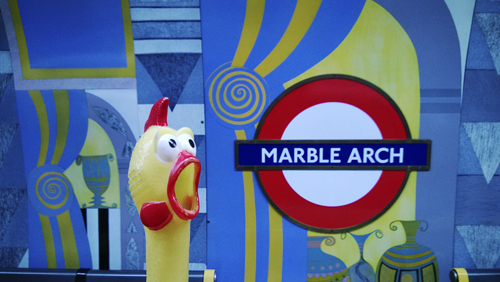
Marble Arch was designed by Nash more or less after the ’Arch of Constantine’ in Rome and the building was originally erected in 1828 in front of Buckingham Palace. It was removed in 1850–51 to its present site where it was an entrance to Hyde Park until 1908. The arch is constructed of Carrara marble.
The station was opened as Marple Arch on 30 July 1900.
MARYLEBONE
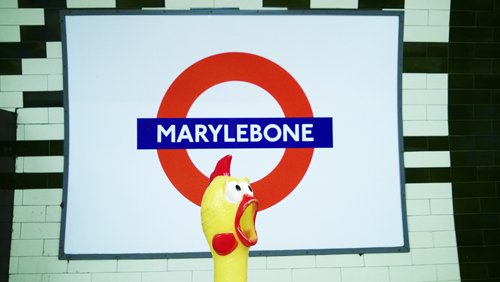
Local feeling with regard to place names should always be taken into consideration, for there is a story regarding how Marylebone received its name. For countless years the place had been known as Tyburn (Tiburne in the Domesday Book) but the association with the tragic tree became too grim and so the local folk took a new name for their parish, being a dedication of the local Church of St Mary-by-the-Bourn, thus ’Tyburn’ became Maryburne and is so recorded in 1453. The le (by or near) was added later, the district being known as Mary le bone in 1746. Tyburn survived until the end of the 18th century with the Tyburn Tree, an execution place, near the present Marble Arch.
During the station’s planning it was referred to as either Marylebone or Lisbon Grove (where the entrance was), but it opened as Great Central (reflecting the ownership of the adjacent main line station) on 27 March 1907; re-named Marylebone on 15 April 1917.
MILE END
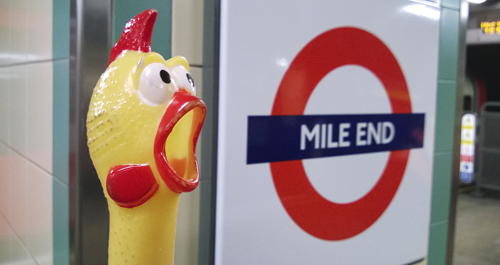
Mile End was recorded as La Mile ende in 1288. The then hamlet was so named because of its position on the old London–Colchester road at the distance of about one mile from Aldgate.
The station was opened as Mile end on 2 June 1902. It was rebuild and re-opened on 4 December 1946.
MILL HILL EAST
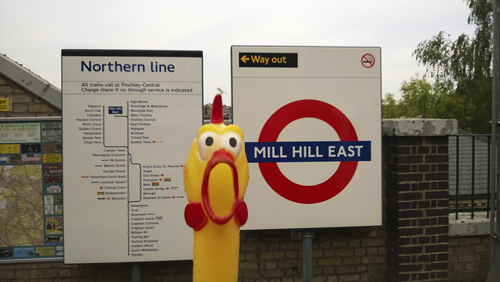
Mill Hill was recorded as Myllehill in 1547 and as the name suggest means ’the mill on the hill’. The original site, Mill Field, lies to the north of the present Mill Hill village but there is no evidence that a mill ever existed.
The station was opened as Mill Hill by the Great Northern Railway on 22 August 1867; re-named Mill Hill East on 1 March 1928. In readiness for its use by Underground trains, the committee of the New Works Programme 1935/40 suggested that a change of name to Bittacy Hill might avoid confusion with other Mill Hill stations. However, Mill Hill East remained when the station was first used by Underground trains on 18 May 1941 mainly to serve the nearby barracks.
MONUMENT
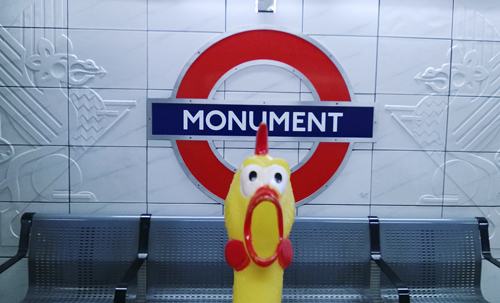
This well-known London landmark was erected during the 1670s and is a hollow column 62 meters high designed by Sir Christopher Wren and Robert Hooke. It commemorates the Great Fire of London in 1666 and the height of the monument is said to be the exact distance from the baker’s shop in nearby Pudding Lane where the fire started.
Prior to the station’s opening it was, for a time, referred as King William Street, but it was opened as Eastcheap on 6 October 1884 and re-named Monument on 1 November 1884.
MOORGATE
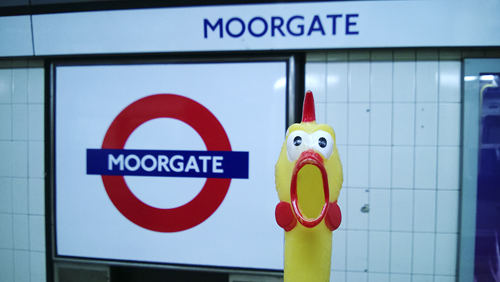
As the name suggests this was the site of one of the gates in the old City wall. The first Moor gate was cut into the wall in 1415 to give access to the moorland lying to the north of London. As the wall was crumbled during the 18th century the gate was demolished in 1760. The thoroughfare called Moorgate was built in 1846 and, in fact, runs from the site of this old gate.
The moor itself was virtually uninhabited and remained unused throughout the Middle Ages except by crowds of ice skaters who gathered in the winter months. As the area was built up over the years, the Moorfields became London’s first civic park and today places such as Finsbury Square and Finsbury Circus are part of the original Moor.
The station was opened as Moorgate Street on 23 December 1865 and re-named Moorgate on 24 October 1924. The Northern Line station, always called Moorgate, was opened on 25 February 1900.
MOOR PARK
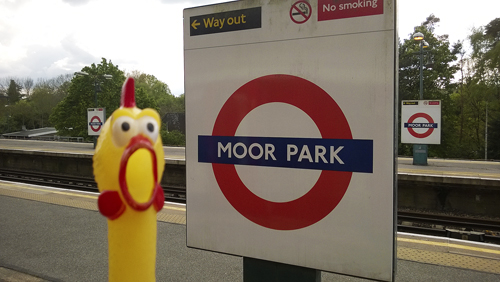
Moor Park was recorded as la More c. 1180 and the meaning is self-explanatory. The original site of the settlement was evidently a Moor Farm which once stood in the River Colne water meadows, near a tract of marshy land.
The station was opened as Sandy Lodge on 9 May 1910; r-named Moor Park & Sandy Lodge on 18 October 1923 and Moor Park on 25 September 1950.
MORDEN
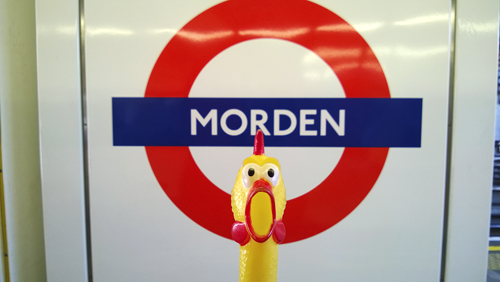
Morden was recorded as Mordone in the Domesday Book and the name is derived from the Old English mor, ’a marsh’ and dun, ’a hill’ – it means ’marshy hill’ but the interpretation ’hill in the fens’ seems more correct. Morden occupies a hill overlooking lower grounds.
Before the station opened, the name North Morden was proposed, but it opened as Morden on 13 September 1926.
MORNINGTON CRESCENT
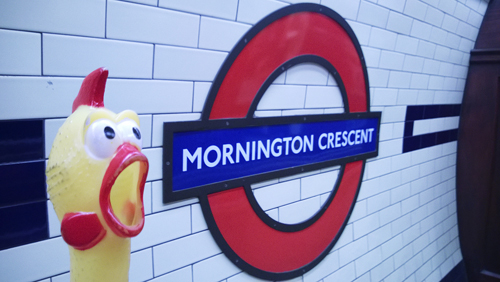
Mornington Crescent was begun in 1821 by Ferdinand, the second Lord Southampton, and is named after a famous connection of the family. For the Lord’s sister-in-law was Anne Wellesley, whose maiden name was Mornington, being the daughter of the Earl of Mornington and sister of the Duke of Wellington.
Prior to the station’s opening the name of Seymour Street was proposed, but it opened as Mornington Crescent on 22 June 1907. It was closed – originally intended to be permanently – on 23 October 1992, but re-opened following refurbishment on 27 April 1998.

